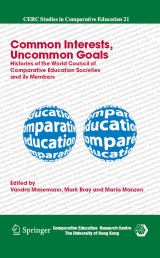Details

Common Interests, Uncommon Goals
Histories of the World Council of Comparative Education Societies and its MembersCERC Studies in Comparative Education, Band 21
|
149,79 € |
|
| Verlag: | Springer |
| Format: | |
| Veröffentl.: | 01.03.2008 |
| ISBN/EAN: | 9781402069253 |
| Sprache: | englisch |
| Anzahl Seiten: | 386 |
Dieses eBook enthält ein Wasserzeichen.
Beschreibungen
distinction Masters student at the University of Hong Kong, who then proceeded to her doctoral studies under the supervision of Mark Bray and myself. Her d- toral research field is closely linked to the subject of this book. The book also benefits greatly from the distinguished authorship of the - dividual chapters. The section on the WCCES itself has been written by former Presidents, some of whom have also had links with the University of Hong Kong either as visitors or, in one case (Anne Hickling-Hudson), as a Commonwealth Scholar. Most of the chapters on the individual societies have been written by Past Presidents of those societies, all distinguished figures in the field th- selves. The book shows that it is possible to talk of a global field of comparative education, of which one manifestation is the WCCES itself. At the same time, the emphases of the field are very different in, say, China, South Africa and France. These are among the factors that make the field so interesting and p- ductive. CERC is proud to make its own contribution to the field in multiple ways, including through the publication of this book. Mark Mason Editor CERC Studies in Comparative Education Series Director Comparative Education Research Centre The University of Hong Kong Introduction Mark BRAY, Maria MANZON & Vandra MASEMANN
The World Council of Comparative Education Societies (WCCES).- The World Council from 1970 to 1979.- The World Council at the Turn of the Turbulent 80s.- From Würzburg to Rio: 1983-1987.- The Long Road to Montreal and Beyond: 1987-1991.- Turmoil and Progress: 1991-1996.- From Sydney to Cape Town to Chungbuk: 1996-2001.- Improving Transnational Networking for Social Justice: 2001-2004.- Expanding the Coverage and Hearing More Voices: 2004-2007.- WCCES Member Societies.- The Comparative and International Education Society (CIES).- The Comparative Education Society in Europe (CESE).- The Japan Comparative Education Society (JCES).- The Section for International and Intercultural Comparative Education in the German Society for Education (SIIVEDGE).- The British Association for International and Comparative Education (BAICE).- The Comparative and International Education Society of Canada (CIESC).- The Korean Comparative Education Society (KCES).- The Francophone Association for Comparative Education (AFEC).- The Australian and New Zealand Comparative and International Education Society (ANZCIES).- The Dutch-speaking Society for Comparative Education (NGVO).- The Spanish Comparative Education Society (SEEC).- The Chinese Comparative Education Society (CCES).- The Brazilian Comparative Education Society (SBEC).- The Comparative Education Society of Hong Kong (CESHK).- The Comparative Education Section of the Czech Pedagogical Society (CES-CPS).- The Bulgarian Comparative Education Society (BCES).- The Polish Comparative Education Society (PCES).- The Southern African Comparative and History of Education Society (SACHES).- The Greek Comparative Education Society (GCES).- The Russian Council of Comparative Education (RCCE).- The Comparative Education Society of Asia (CESA).-Completing the Family Picture.- Lessons from the Histories.- Comparing the Comparers: Patterns, Themes and Interpretations.
<P>The World Council of Comparative Education Societies (WCCES) was established in 1970 as an umbrella body which brought together five national and regional comparative education societies. Over the decades it greatly expanded, and now embraces three dozen societies. </P>
<P></P>
<P>This book presents histories of the WCCES and its member societies. It shows ways in which the field has changed over the decades, and the forces which have shaped it in different parts of the world. The book demonstrates that while comparative education can be seen as a single global field, it has different characteristics in different countries and cultures. In this sense, the book presents a comparison of comparisons.</P>
<P></P>
<P>This book presents histories of the WCCES and its member societies. It shows ways in which the field has changed over the decades, and the forces which have shaped it in different parts of the world. The book demonstrates that while comparative education can be seen as a single global field, it has different characteristics in different countries and cultures. In this sense, the book presents a comparison of comparisons.</P>
No other book has focused as extensively on the histories of comparative education societies, written by their founders and successors An explicitly comparative work which compares the comparers in different parts of the world Presents an illuminating account of the factors that have influenced the shape of the field of comparative education Authored by distinguished figures in the field of comparative education

















